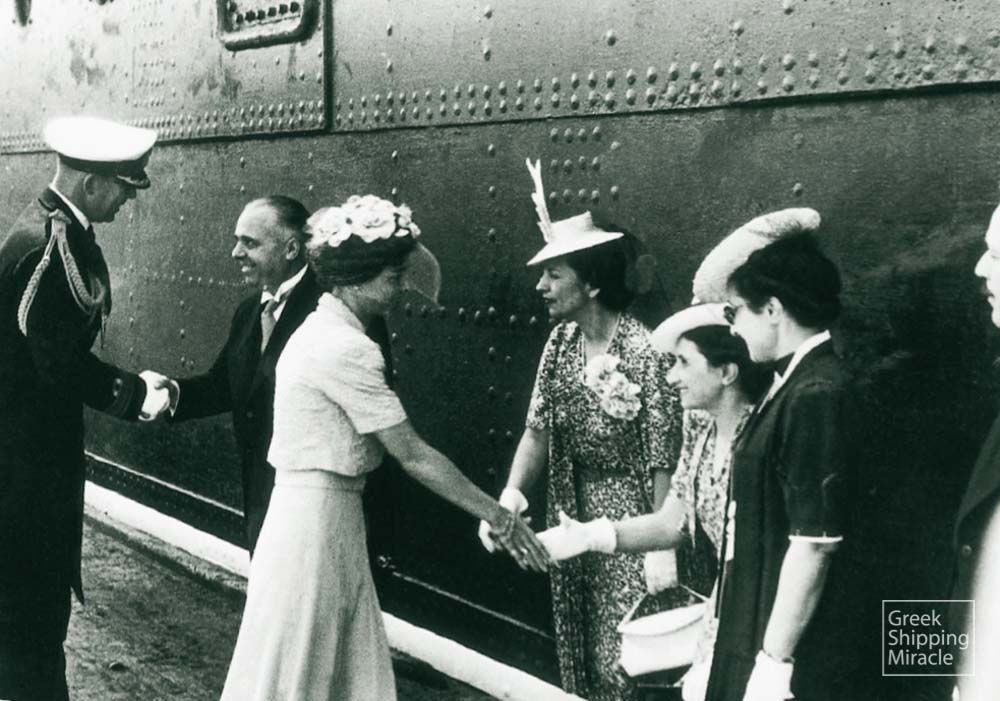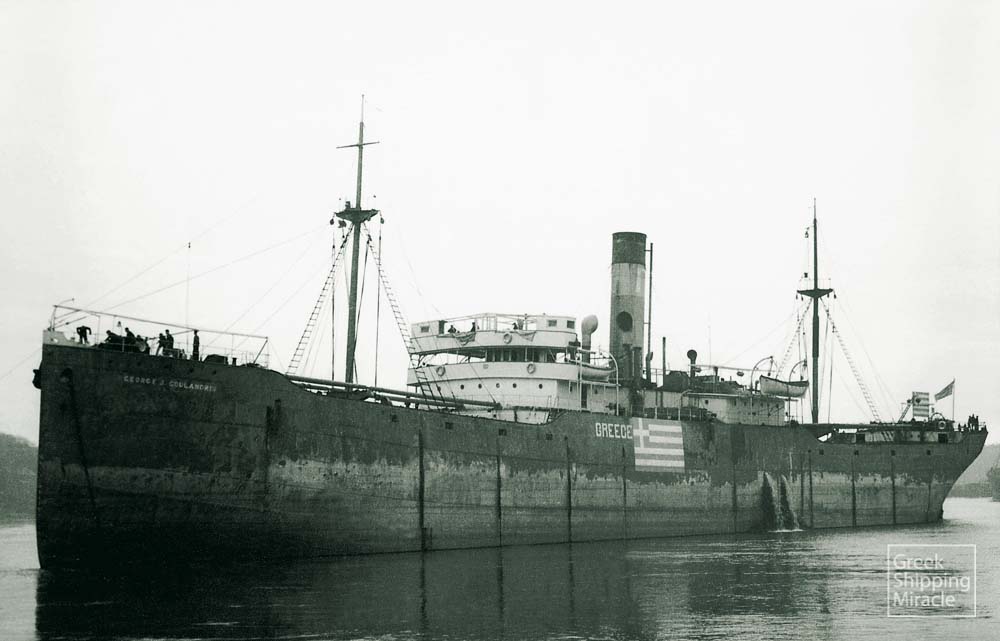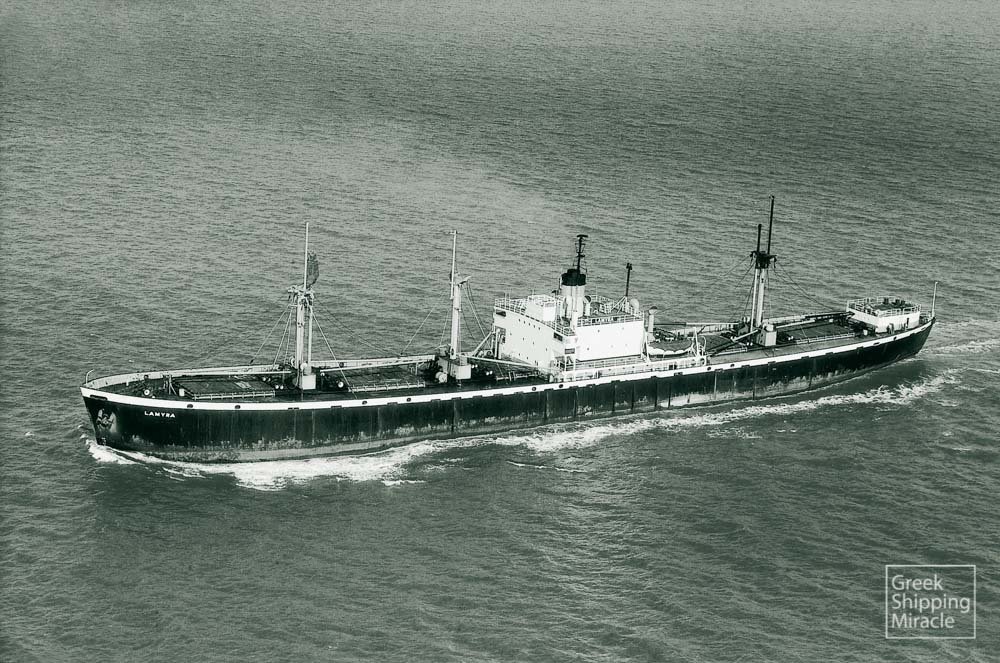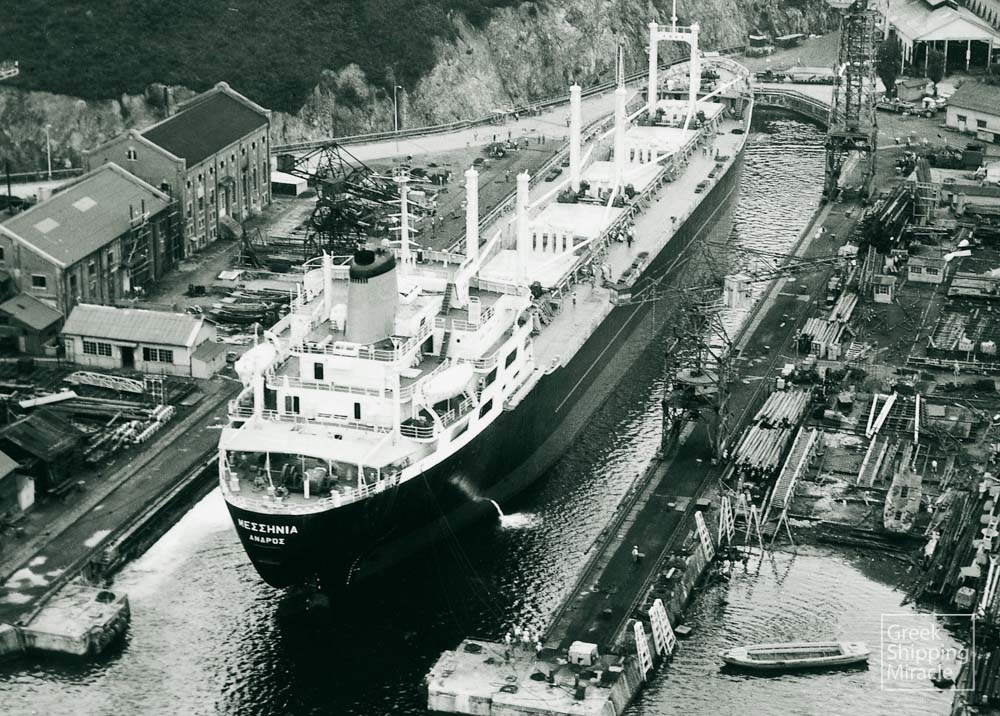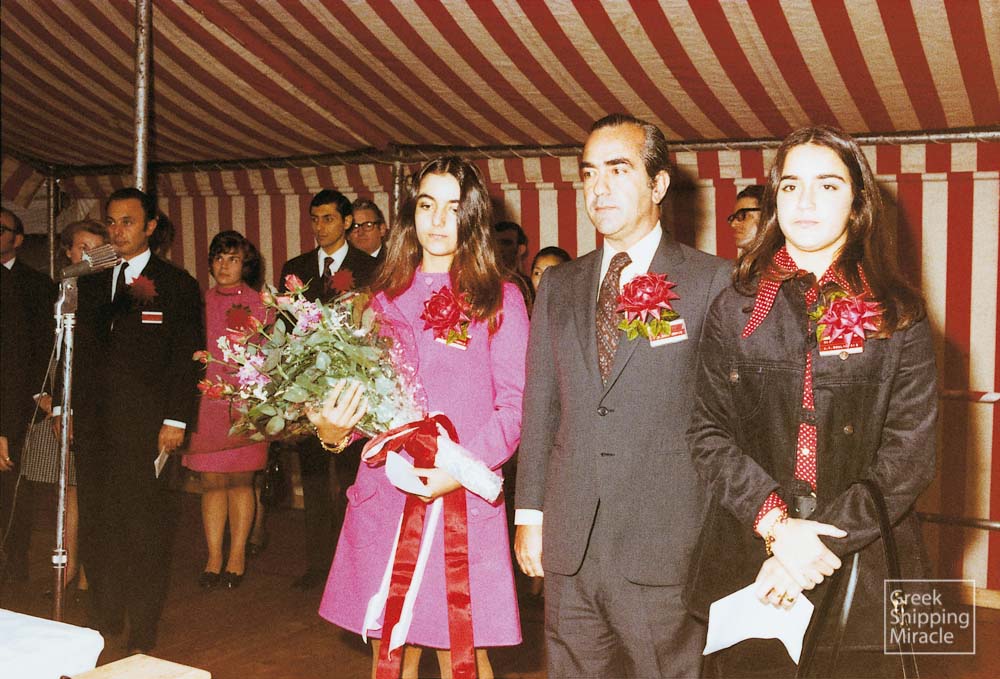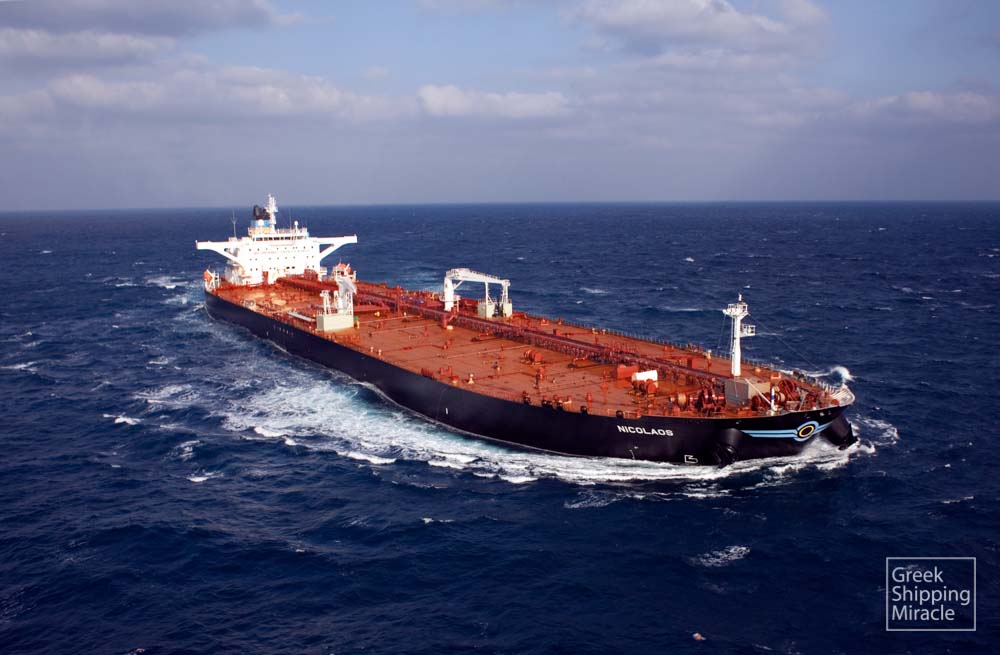ANDRIAKI SHIPPING CO. LTD.
The N.J. Goulandris Group founded in 1953 is one of the most distinguished successors of the Goulandris renowned shipping family from the island of Andros.
Ioannis P. Goulandris (1840-1927), founder of the family, was a master mariner and owner of sailing ships in the second half of the 19th century, before taking over as captain on steamships of his great compatriot shipowner Dimitrios Moraitis. In 1901 he became a minority partner in a six-year old steamer, the CORNILIOS, acquired by his relative Cleanthis A. Polemis and Menelaos Cornilakis, a rich merchant from the island of Syros. The ship sailed until February 7, 1910 when she was wrecked.
In August 1910, Ioannis P. Goulandris supported by his five sons, Petros (1877-1931), Michael (1878-1935), Vassilios (1886-1976), Nicholas (1891-1957) and later Leonidas (1902-1952), and financially assisted by his compatriot Epaminondas C. Embiricos, managed to acquire a British steamship which was renamed IOANNIS P. GOULANDRIS. Three years later, one more steamship, which was renamed MARIONGA GOULANDRIS, was added to his fleet.
Both ships achieved significant earnings from their operation during World War I, but were lost through enemy action in May and June 1917 respectively. The family remained without ships, but had in the meantime accumulated substantial sums in cash.
The sons of Ioannis P. Goulandris returned to shipping business in 1924, acquiring good quality second-hand ships at very attractive prices. They had already set up offices in Athens and London, which apart from serving the growing family fleet, served as a starting point for the development of several shipowners from the island of Andros, by financing and managing until the beginning of World War II about 40 ships owned by their compatriots.
In 1927 Ioannis P. Goulandris passed away. The following year, there was an important change within the structure of the family group; Petros J. Goulandris, the eldest brother, acquired a steamship of his own. This acquisition marked the beginning of a new Goulandris enterprise which operated from independent offices in Athens. Three years later, however, Petros J. Goulandris suddenly passed away and the ship was placed under the management of Goulandris Bros. until 1937 when his children established an individual office under the name “Heirs of the late Petros J. Goulandris”.
In the meantime, the progress of the Goulandris Bros. enterprise during the 1930s had been impressive. They took advantage of the serious downfall in ship values following the deep economic crisis that followed the 1929-crash of the New York Stock Exchange and, between the years 1932 and 1936 added no less than seven more steamships to the family fleet.
In 1935 the family mourned the loss of another of its members with the passing away of Michael J. Goulandris. Two years later, his heirs decided to act independently with the acquisition of a steamship, which was yet lost during the War.
Just before the outbreak of World War II, the three remaining brothers Vassilios, Nicholas and Leonidas J. Goulandris decided to re-establish the transatlantic line, which had been at a standstill since 1935 following the demise of National Steam Navigation of Greece, which had been founded by the Embiricos family. In this context, in 1939 they acquired the British passenger ship TUSCANIA, built in 1922, which was renamed NEA HELLAS and was also registered in Andros.
During World War II the Greek merchant fleet was devastated, having lost over 75% of its pre-war power. The Goulandris Bros. Group suffered enormous losses. At the end of the War only a couple of its pre-war steamships, the ANNA N. GOULANDRIS and the PETROS J. GOULANDRIS had survived. The passenger ship NEA HELLAS, which was requisitioned by the British and operated as a troop carrier during the War, had also miraculously survived; despite the fact that she was torpedoed and damaged by a German submarine.
The first post-war years
The post-war reconstruction of the Goulandris Bros. shipping enterprise proved to be a Herculean task, which was accomplished thanks to the determination of its principals. The traditional Goulandris family Group had remained under the control of the three brothers, Vassilios, Nicholas and Leonidas. At the same time, a new generation of family members were already active within the Group; Vassilios’ sons, John and Constantine, Nicholas’ sons, Giannis, Alecos and Leonidas and finally Leonidas’ son, Giannis.
Under extremely adverse circumstances, and especially given the fact that the civil war that had broken out in Greece did not allow any serious business activity to develop, Goulandris Bros., as well as most of the Greek shipowners, had to continue their shipping business from abroad –mainly in the United States of America and the UK– acquiring ships under foreign flags. Goulandris Bros. became active mainly in the Canadian market and established companies which, from 1946 for a period of few years, operated a significant number of ships built there during the War. A number of other British flag ships, also mainly constructed during the War, were placed under the Goulandris Bros. management in London. Among them there was an aircraft carrier, the EMPIRE MACKENDRICK, built in Scotland in 1943, which was converted into a cargo ship and sailed under British flag as the GRANPOND.
Beyond the above ships, Goulandris Bros acquired two Liberty type ships –from the 98 sold to Greek owners by the US Government at the end of 1946 and early 1947. At the same time, the Group continued operating ships belonging to other owners from the island of Andros, thus assisting their compatriots towards the post-war reconstruction of their fleets.
The family Group also continued being involved in passenger shipping. Apart from the NEA HELLAS, which had been placed again under their management in 1947, three more units were added to their fleet. These were the CANBERRA, the NEPTUNIA and the COLUMBIA, all placed under Panamanian flag.
At the beginning of 1952 however, the passenger fleet was separated from the Group following an agreement between the three brothers. Vassilios and Nicholas maintained the cargo ship fleet whereas Leonidas took over the passenger fleet, to which a newbuilding, the OLYMPIA, built by the Alexander Stephen shipyard at Glasgow, was due to be delivered in 1953. However, in September 1952 Leonidas J. Goulandris suddenly passed away and the passenger shipping enterprise, which became widely known as the Greek Line, was continued by his son Giannis.
At about the same time, the Nicholas J. Goulandris Sons acquired the Liberty type cargo ship SEAPIONEER, which was renamed LAMYRA, from their relatives P.J. Goulandris Sons. The vessel was registered in Panama and was placed under the management of an independent office in New York, the United Operators Shipping Agencies Corp.
The N.J. Goulandris Group
The establishment of the N.J. Goulandris Group took place in 1953 when the family of Nicholas J. Goulandris decided to separate its business activities from the parent company, Goulandris Bros. The separation resulted in the formation of a new office in London under the name N.J. Goulandris Ltd. At the same time, another office was established in Piraeus, Andriaki Shipping Ltd., which took over the management of the Liberty type cargo ship LAMYRA, as well as three more similar type ships which were acquired in 1953.
At the same year of its establishment, the new group took delivery and placed under its management its first newbuilding. It was the tanker LEONIDAS –being a joint venture of the N.J. Goulandris family with their relatives, the Condylis family– constructed by the Nippon Kokan K.K. shipyard at Shimizu, Japan. It further marked the start of an extraordinary bond between the Group and Japanese shipyards –which has produced up to now 69 units– marking the entrance of the Group into a new field of maritime activity, where they were destined to become among the world’s leading players.
By the end of 1953, and while the sons of Nicholas J. Goulandris were busy planning a large shipbuilding programme in Japan, the transfer of several cargo ships operated up to then by Goulandris Bros. to the new Group, started taking place according to prior agreements that had been made within the family. Every transfer was effected upon the completion of each ship’s commitments towards its charterers. The first ship that joined the new Group’s fleet was the CONDOR in 1953 followed in 1954 by five cargo ships built during the War. Another addition to the fleet was one of the two steamships that had survived the War, the ANNA N. GOULANDRIS which was renamed ANNA. Furthermore, there were also five new acquisitions, four of which were Liberty type ships. At the same time, the new group placed under its management several cargo ships belonging to other owners from the island of Andros, a practice that was followed up until 1963.
In 1955, one more Liberty type ship was acquired and added to the fleet. The next year was however a milestone for the N.J. Goulandris Group as during its course a total of six newbuildings were delivered to its management from Japanese shipyards. The ships were the tankers ALEXANDRA I and MARIETTA, the cargo ships DEVON and CORNWALL and the bulk carriers ARAGON and GRANADA. The two bulk carriers went on record as the first newly-built Greek owned ships of this type. They also marked the beginning of the heavy involvement of Greeks in a new field of transportation activity, the dry bulk trade, in which they were to demonstrate excellent performance over the next decades and until today.
In the same year and while his family’s newly-founded Group was setting high goals towards its evolution, Nicholas J. Goulandris took the initiative to honour the Greek Seafarer by commissioning the renowned Greek sculptor Michael Tombros with the construction of a giant statue for the Unknown Sailor. The statue would be placed on a central square in his birthplace Andros. Beyond the cost for the construction of the above statue, Nicholas J. Goulandris and his family undertook to renovate an old traditional building located in the same square which was planned to become a maritime museum.
In 1957, the Group’s fleet was further strengthened through the addition of five more newbuildings and another cargo ship from the Goulandris Bros. operation. The newbuildings were the cargo ships NAVARINO and ARGYLL and the tankers MARATHON, CASTELLA and ANNA. A sad event, however, shadowed this productive year for the Group, the passing away of Nicholas J. Goulandris, whose work was to be continued by his sons Giannis, Alecos, Leonidas and his daughter Anna.
The following years were difficult for world shipping as the market went sharply down forcing many ships into lay-up berths. Despite this development, the N.J. Goulandris Group continued its impressive growth by adding more ships to its fleet, both newbuildings and second hand ones. In 1958, two more Liberty type ships were acquired, while at the same time four newbuildings, the tankers NEAPOLIS and VIOLANDA and the cargo ships DERBY and DORSET further enhanced the quality of the fleet operated by the Group. It is worth mentioning that the VIOLANDA was the largest tanker built until then in Japan, and moreover was sponsored by the wife of the Emperor’s brother, princess Takamatsu. This was an outstanding honour for the Group, the tanker being the first foreign-owned ship built in Japan sponsored by a member of the Imperial Family. This was indicative of the Japanese appreciation for the great support the N.J. Goulandris Group was offering to their shipbuilding industry through its extensive newbuilding programme.
In 1959 there were further additions to the fleet. The newly-built tanker ANTIPOLIS was the first newbuilding of the Group to be registered in their homeland Andros. At the same time, a French T2 type tanker came into the fleet. On 5 November 1959, during a grand ceremony in the island of Andros, the statue of the Unknown Sailor was revealed in the presence of the Greek Royal Family.
At the end of the first post-war decade, the N.J. Goulandris Group fleet was further strengthened through the addition of three newbuildings and two second-hand tankers. In particular, two bulk carriers were delivered, the sister ships LACONIA and MESSINIA, as well as the tanker ship ATTICA. Moreover, two tanker ships acquired and renamed MILITOS and EFESSOS, both under Liberian flag.
At the beginning of the 1960s, shipping was still in heavy crisis. Despite this, the N.J. Goulandris Group continued its growth in terms of new acquisitions as the majority of its ships were employed on a long term basis by first class charterers, a policy adopted since the early years of its establishment. Whereas the pace of taking newbuilding deliveries was slowed down, especially during the first years of the decade, the tally of newbuildings delivered to the Group until its end were an impressive 17 units joined by five ships of different type from the second-hand market.
In particular, the bulk carrier AETOLIA and the cargo ship APOLLONIA were delivered by their builders in 1961 and the cargo ship LINDOS in 1962. In 1963, two sister tankers the PERSEPOLIS and the CORINTHOS were delivered, while a British second hand tanker came into the fleet as the AMPHIALOS. In 1964 there were four more newbuilding additions to the tanker fleet of the Group, the sister ships NICHOLAS J. GOULANDRIS and PRINCESS ANNE-MARIE and another pair of sister tankers, the TRIPOLIS and the ARGOLIS. In the same year, a bulk carrier, TOKYO OLYMPICS was delivered from Fuginagata shipyard marking the 30th newbuilding constructed in Japan and placed under the N.J. Goulandris Group operation. On this occasion, and during the delivery of the above ship, the Minister of Transportation Shutaro Matsuura, on behalf of the Japanese Government, honoured the N.J. Goulandris Group “in acknowledgement of distinguished contribution rendered to the development and progress of the shipbuilding industry of Japan”. The same shipyards delivered to the Group two more bulk carriers in March 1965 and July 1966, the ANDROS and the ANTIGUA respectively, whereas in 1965 Uraga shipyard delivered the tanker MICHAEL J. GOULANDRIS. In November 1967, the Group took delivery of its first and only ore/oil carrier, the CALEDONIA. During the same year, the cargo ship OCEANIC, built in 1961 for a company controlled by relatives of the family, joined the fleet retaining the same name.
The year 1968 was a special one for the Group and for Greek shipping in general, as in June 1968 the delivery of NICHOLAS J. GOULANDRIS from the Sakai facility of the Hitachi Group marked the registration of the first VLCC under the Greek flag and the biggest ship ever delivered up to that time to Greek interests. Within the same year, one more tanker from the second-hand market was added to the fleet as the CLARENTIA. Two more second-hand tankers delivered in 1969 and renamed MANTINIA and ROMELIA were additional acquisitions in an extremely productive decade for the Group which included another important initiative by its principals. This was the acquisition of the Neorion Shipyard on Syros island, a historic ship repair-facility belonging to traditional shipowners Nicholas and Minas Rethymnis.
This important investment was not merely another business venture by the principals of the Group, but also mirrored their wish to contribute decisively towards the development of the Cyclades group of islands and especially of an island which had played a major role in the evolution of Greek shipping. Over the next years, Neorion shipyards achieved an impressive rate of growth under the control of N.J. Goulandris Group, offering at the same time invaluable work opportunities to a great number of the local population. Beyond the above contribution to the economy of the Cyclades, the N.J. Goulandris family offered to the island of Syros a superb monument to honour the Greek merchant marine, created by the leading contemporary Greek sculptor, Ioannis Pappas. The monument is situated in front of the historic building of the Customs Authorities in the port of Syros. Furthermore, the family donated two newly-built fast patrol boats to the Greek Navy. The boats were built at Neorion and were named N.J. GOULANDRIS I and II. It is also worth mentioning that John N. Goulandris took the initiative to establish within Neorion a facility for the construction of Enfield-type electric-driven cars.
During the early 1970s, the Group invested heavily on building bulk carriers in various Japanese shipyards. Between the years 1970 and 1973 an impressive total 14 ships of this type were delivered to its management. In detail, in 1970 Hitachi shipyards delivered the CORONIA and ALKYONIA. In 1972 the same shipyards delivered the ORESTIA, OLYNTHIA and ANTIOCHIA whereas Sanoyasu shipyards delivered PARALOS, PERGAMOS and PANORMOS and Hakodate shipyards delivered the SAPPORO OLYMPICS and the AVLIS. In 1973 there were four further deliveries, the EVRYALOS and ARIANA from Sanoyasu, the LOKRIS from Hakodate and CARYANDA from Hitachi. In the meantime in 1972, Nippon Kokan K.K. had delivered the VIOLANDO N. GOULANDRIS, a VLCC named after the wife of the Group’s founder.
A different approach to new acquisitions was employed during the second half of the decade. The principals of the Group decided following the rapid changes in the tanker market to strengthen its fleet with newbuildings as well as second-hand units. In 1975, four newly-built tankers joined the fleet, the MARIETTA, EPHESOS, MILITOS and NAFKRATIS. In 1976 a Norwegian and a Liberian tanker were purchased and were renamed PALMYRA and SELEFKIA respectively. In 1977 finally, a British flag tanker was acquired and was placed under the Group’s management as the MARAKANDA.
Just before the end of the decade the Group’s bulk carrier fleet was enhanced through the addition of three second-hand bulk carriers in 1979 and in 1980. Another newly-built tanker, the IONIA, was delivered in 1980 from the Hitachi shipyard facility at Hiroshima.
The 1980s were highlighted by a long and deep crisis that caused major upsets in world shipping. Despite this adverse situation, the N.J. Goulandris Group continued taking deliveries of new ships while at the same time many owners from all over the world were forced to abandon their newbuilding programmes, especially in Japanese shipyards. In 1981 Ishikawajima-Harima Heavy Industries delivered two tankers to the Group, the NEAPOLIS and the ANTIPOLIS followed by another sister ship, the NICOPOLIS in 1983. During the same year, there was one more newbuilding delivery, that of the bulk carrier LAMYRA, while the sister ship ANDROS was delivered in 1985.
In the course of the next ten years, and while the shipping market experienced a slow recovery, the Group maintained a low profile attitude avoiding any further investment in newbuildings. It fully utilised the services of the ships already in the fleet and covered, when necessary, its requirements in tonnage through several acquisitions from the second-hand market.
During the first five years of the 1990s, and while the responsibility of the operation of the Group passed gradually to a new generation, the fleet was further strengthened with the purchase of four second-hand panamax bulk carriers.
In 1995, the inauguration of the restoration of the Tourlitis lighthouse in its original shape took place, during a special ceremony at the Rivas Place in the island of Andros. It is a great monument of the Greek maritime tradition that survived thanks to initiatives of Alecos N. Goulandris and his wife Marietta Goulandris, in memory of their daughter Violanda who had recently passed away.
The year 1995 also marked the return of the Group to the shipyards with the delivery of its first newbuilding in ten years. The ship, a double hull high specification tanker was delivered from the same builder that had delivered the first tanker of the Group in 1953. She was named VENETIA and was the 61st newbuilding delivered to the Group by shipyards in the country of the Rising Sun in 42 years time. Just before the end of the century, in 1999, a second-hand bulk carrier, the AMPHION was added to the Group’s dry cargo fleet.
At the beginning of the new century, the N.J. Goulandris Group, with its management team strengthened with members of the fourth generation since its establishment, initiated a fresh newbuilding programme aiming at the complete renewal of its fleet. For the first time in its history, the Group contracted newbuildings in South Korea taking delivery of two VLCCs, the ARION and VIOLANDO from Samsung Heavy Industries in 2001 and 2003 respectively and of the bulk carrier ASPENDOS from Hyundai Samho Heavy Industries, also in 2003. In 2004, a second hand eight year old bulk carrier joined the fleet as the KRONOS. In 2005 the Group returned to Japan to take delivery of the newly-built tanker ARIANNA, constructed by Sasebo Heavy Industries, while two more tankers, the NEAPOLIS and ANTIPOLIS were delivered from the same shipyard on year later.
In 2006, the Group placed orders with Tsuneishi shipyard in Japan for the construction of four bulk carriers of 82,100 dwt. It was followed by another order with Tsuneishi shipyard, in China this time, for the building of two similar size ships. In particular, the Tsuneishi shipyard in Japan delivered the KESARIA in 2009 and the ATTALIA, MYRA and TYANA in 2010; while the Tsuneishi shipyard in China delivered the ANDROS and PELLA in 2010.
Apart from these six newly-built bulk carriers, the Group took delivery of four tanker ships, 164,000 dwt each, by Hyundai Samho Heavy Industries in South Korea. The VIOLANDO in 2009, the NICOLAOS in 2010 and the MILITOS and EPHESOS in 2012. A VLCC, also built in 2009, the 318,352 dwt LEONIDAS was constructed by Hyundai Heavy Industries in South Korea.
For over six decades, the N.J. Goulandris family is one of the most qualitative and productive groups within Greek shipping, having a fruitful presence with a total of 79 high quality newbuildings of all main types. This outstanding performance has already well established the Group amongst the leaders in the contemporary history of the Greek Merchant Marine with international distingtion.





